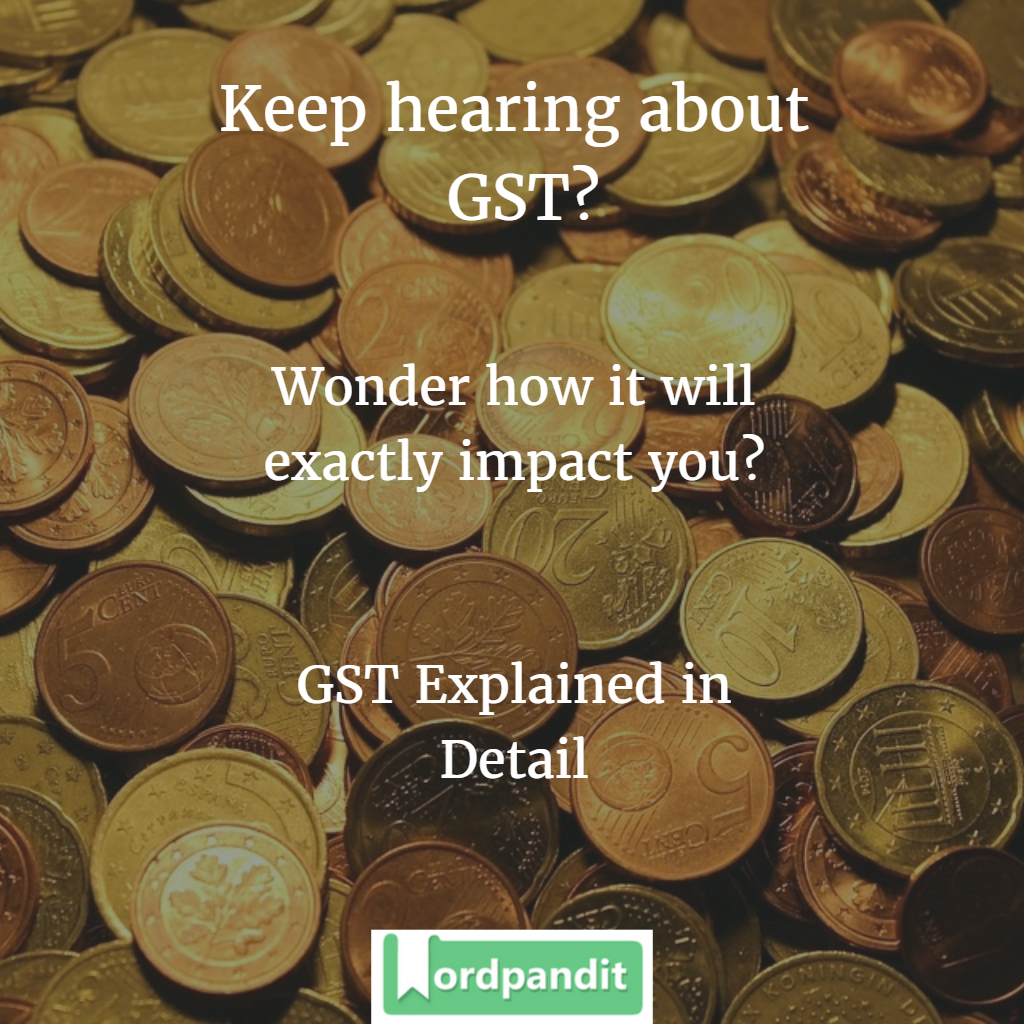GST Explained in Detail: Learn all about GST
Today, when everyone is baffling around to know what GST is, here is an insight of it. So, starting with what is GST, moving to why it is important, to how it will be implemented ending to its advantages and disadvantages.
GST is GOOD and SIMPLE TAX in India (official full form: Goods and Services Tax). It is a step forward to make our country unified under the umbrella of one major tax removing all the taxes implied by the central and the state government. In layman’s language, it is the single tax that will travel through the manufacture to the customer. Key words in the definition are:
MULTISTAGE TAX – This means the tax will be collected at every step of the chain from the manufacturer to the consumer i.e. first at buying raw material then at manufacture end, then at selling to wholesaler, then at retailer and at last at the consumer end.
Making it consumer friendly i.e. the final consumer will pay only the GST levied on the last dealer in the supply chain by the government, with the set off benefits at all previous stages.
DESTINATION BASED TAX – Earlier, when the product was manufactured, the centre levied excise duty on the manufacture and then the state levied VAT when the item is sold in the next step of the supply chain, then there would VAT on the next stage and the cycle goes on. Now, only one tax i.e. GST will be levied on every step of supply chain.
For example: if the product is manufactured in Punjab but then it is to be sold in Haryana. According to GST, Punjab will get the revenue in the manufacturing and warehousing stages and Haryana will get revenue on the final sale of the product.
INPUT CREDITED TAX – This point lies in the fact that the final liability of the end consumer is decreased by allowing the seller to claim the tax already paid.
Now, the importance of GST lies in the fact that it subsumed all the direct and indirect taxes i.e. direct taxes meant that the liability of the tax can’t be passed on to the anybody while indirect taxes meant that the liability can be passed on to the anybody mainly consumer.
The working of GST will be simple enough with only three terms in use now i.e.
CGST – Where the revenue will be collected by the Central Government
SGST – Where the revenue will be collected by State Government for intra-state sales
IGST – Where the revenue will be collected by Central Government for inter-state sales.
Sales within the state = CGST+SGST
Sales to another state = IGST
For more Current Affairs Click Here
Benefits of GST:
- Robust and comprehensive IT system is the base of the GST regime in India. Now, all the registrations, returns, payments etc. will be done online so there the system of taxes will be transparent and easy to get into compliance.
- There will be a certainty that tax structures and rates are common across the country.
- There is no passing over or cascading of taxes i.e. there will be no hidden costs in the taxes.
- Reduction in transaction costs will help in improving competitiveness in the industry.
- It will give a boost to Indian goods and services as they will be cheaper in the international market.
- For the governments it will be easy to administer.
An Example shown below makes an effort to explain GST:
STAGE 1:- Taking an example of a manufacturer, say cakes is the product we think upon. So, he bought raw material such as white flour, sugar, flavours and toppings and the baking oven. Suppose all this raw material cost him Rs.100. This Rs.100 includes a tax of Rs.10. In the process of baking, the baker added value to the materials he started out with, let us take it as Rs.30. Now the gross value of the cake is Rs.130. At the tax rate of 10%, the tax to the cake comes out to be Rs.13. Now in the case of GST regime, the baker is able to set off this tax, he had already paid on the raw material is Rs.10. Therefore, the effective GST is only Rs.3.
STAGE 2:- The next stage is the passing of the cake to the wholesaler from the baker. The wholesaler purchases it for Rs.130 and adds on the value (his margin) say of Rs.20. Now the gross value of the cake comes out to be Rs.150. A tax of 10% on this is Rs.15. But again, under the GST regime, the wholesaler can set off its tax i.e. Rs.15 against the tax on his purchased cake from baker. Therefore, the tax effective against is Rs.15- Rs.13=Rs.2
STAGE 3:- This is usually the final stage; the retailer buys the cake from the wholesaler. To the purchase price i.e. Rs.150; he adds to it his margin of Rs.10. So, the whole price goes up to Rs.160. Say the tax on it is 10%, it becomes Rs.16. Now again the effective tax under GST comes out to be Rs.16-Rs.15=Re.1
Now adding all the taxes and the base price, the total effective GST comes out to be Rs. 10+3+2+1 = Rs.16.
So, all in all it is a good step towards the progress of our country. Rest let us see how our people change themselves to accept the development of the country they live in.
Stay tuned for more updates!!
For more Current Affairs Click Here













GST is Goods and Services Tax not Good and Simple tax.
Hey that is just a language pun intended.